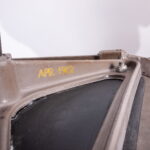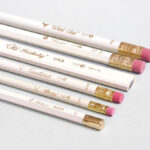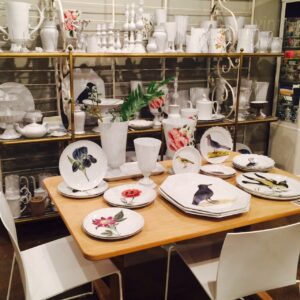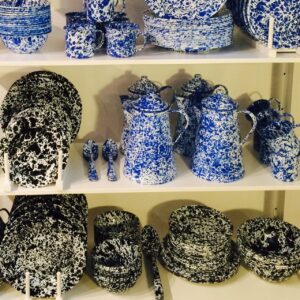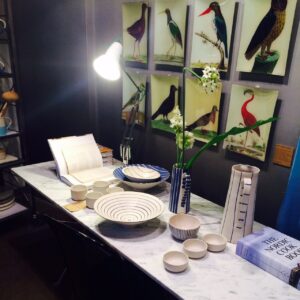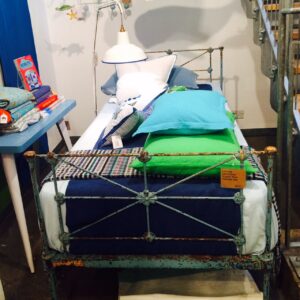When we started this Merchant & Found gig a few years ago, we were driven by our passion (polite way of saying obsession!) for some of the famous makers in the furniture and lighting world, principally the makers that were born at the turn of the Twentieth Century, the industrial pioneers. We had some knowledge but have been stunned and delighted to discover so many amazing makers we just didn’t know about. If you take bentwood chairs as an example, we knew Thonet and Ton really well, but we hadn’t heard of Baumann, Fischel or Luterma and uncovering this history has (along with meeting so many amazing customers and suppliers) been one of our greatest pleasures over the last few years. Google is a pretty useful tool but you have to dig deep and really unpick the history to put it all together, we are talking huge industrial producers who were major contributors to the development of the home interiors over the last one hundred or so years, yet their history is almost gone and forgotten. The list goes on, Benjamin lighting, Esavian, Strafor, Fibrocit or Evertaut, just to name a few. We have honed our mission, we want to champion these amazing makers, we want to sell their vintage products but we want to champion their history and provenance along side everything we sell. Why just buy a vintage chair, why not sit on a chair with history, a chair with a makers mark, a survivor of an incredible phase in our industrial history.
We have a romantic core so uncovering these old makers has definitely got a bit of an Indiana Jones vibe (we kid ourselves honestly) but it does feel like that, finding dusty old catalogues, crawling under piles of chairs to find the makers label and simply just hunting out this history. These makers made some incredible products and it just seems a travesty that this history might be lost so our simple mission is to do our best to authenticate pieces, to unearth the history, to record it and share it. We have a crazy romantic notion that one day we might put it all in a book, but one step at a time.
So what’s the ‘next phase’ we hear you ask? Simple, we love vintage but above and beyond that we love these makers and what they stand for and step by step we want to tell their wider story, not just the ones that have sadly stopped trading but (drum roll…) we want to start discussing the makers that have survived. So without further ado we are incredibly proud and excited to say we are now working with two amazing French makers that have survived and are still trading today, Tolix and Nicolle. Put simple we want to champion these brands, to tell the brand story, to be the best place to come and buy vintage Tolix and Nicolle but also to sell brand new (just made) genuine Tolix and Nicolle. Yes we love their vintage products but above all what we love is their incredible products, their history, their drive to survive and we want to be part of that. So from today, we are official distributors of these two incredible brands. We have a huge amount of work to do with our website but over the coming weeks and months we will be loading all the contemporary products that Tolix and Nicolle make today and you won’t be surprised to hear that of course they still produce their iconic classics but they also keep driving their brands forward working with new bold designers to keep creating great products for the next one hundred years.
Over the coming weeks and months we will share more insight in to these incredible makers, their history and their current product range but in the meantime if you want a Tolix or Nicolle product we can supply you both vintage products and anything from their current ranges. Until we have the full product ranges loaded on our website please contact us and we will do our best to help supply you with any product from these two incredible makers.paul@merchantandfound.com
With best wishes
Merchant & Found
Tan-Sad began life in 1922 in Birmingham and was first publicly listed as an exhibitor at the British Industries Fair, selling typists tables, constructional toys, motor cycle chairs, perambulators and office and factory chairs. Tan-Sad Continued to grow over the coming years and essentially split its Birmingham production between push chairs and toys, and a very successful range of factory and office seating.
In the 1950’s and 1960’s Tan-Sad became a generic name for pushchairs and traditional perambulators before it’s demise in 1975. Ask a certain older generation and they will still to this day refer to a pushchair as a ‘Tan-Sad’. The original meaning behind the name is believed to come from the French word Tansad, meaning the extra or pillion seat behind a horse or motorcycle. Sadly little more than this is known about Tan-Sad except for various vintage advertising and of course vintage products that have survived. Our interest lies mainly in the iconic machinists chairs that were mass produced from the 1930’s onwards, competing head on with Evertaut in England as well as a number of big European manufacturers.
The machinists chair was born from the use of industrially produced steel tube that post the First World war was produced in such scale that it became a key new material in furniture production. The Bauhaus school was one of the pioneers of its commercial use in seating. The early Tan-Sad chairs are iconic in their use of vulcanised cardboard for the seats and backs. A tough and practical material that was suited to the harsh environment of the factory floor. With no fabric upholstery it could be cleaned with a damp cloth, was fairly resistant to fire, and yet would gently mould to a comfortable shape.
We have been lucky to recently come across a batch of early machinists chairs in exceptional condition and are able to pick out the key highlights from the early 1940’s production. The seats swivel and are height adjustable using a basic locking screw and pin that wedges into a channel cut into the seat upright, as time progressed (in the late 1950’s) this system was updated and the seat swivelled and adjusted on a threaded base, reducing cost by (sadly) removing the need for the lovely Tan-Sad branded adjusting handle. The seat bases were originally made from welded steel but this too was replaced with a mass production cast base in the late 1950’s. Interestingly throughout these changes the original and highly practical vulcanised cardboard remained as did the lovely rubber bumpers used behind the curved back rest to cushion the attachment of the backrest to the main frame and allow some movement.
Our interest lies mainly in the machinists chairs of which many varieties exist although the model shown below is the best know. Very occasionally you will see an original 1920’s horse hair stuffed and upholstered version, if you do, snap it up it’s a rare part of our industrial heritage.
Help us champion recording the history of these iconic industrial brands. If you can help us in our mission please get in touch!
- test
Little old naive me loved the simplicity of the Field Notes books but I had no idea of their history. I was exploring their site the other day when I stumbled across their archive. Co founder Aaron Draplin tells the story better than I ever could so please follow the link at the end of this journal entry and explore. The history of Field Notes is very special and what I really admire is Aarons passion and vision to recognise the greatness in these little books he found whilst rummaging around at flea markets and to take that wealth of history and make it relevant. Perhaps Aaron’s archive is one of the only remaining reference points? I love glimpsing in the past to see a different way of life, a slower pace and a medium that was somehow socially and commercially accepted as a way of selling and advertising agricultural goods and yet also practically helping farmers with a practical note book. Hats off to Aaron and team.
Field Notes Archive
These guys are one of my all time favourites, going about what they do in a quiet off the radar way. Their website is faultless, beautifully designed. The product selection is wonderfully curated and in my view not at first that commercial but by sticking to their philosophy they have created a powerful brand which has the potential to be infinitely commercial but that is not the point. They do what they do out of love and passion and it shows, yes you want to buy the products but first and foremost you just want to be immersed in their world. They make graphic design/creativity an artwork. They make old pencil boxes supremely sexy. I love the mix of old and new and the no compromise passion to hunt out ephemera from all corners of the globe. Make sure you check out the blog, WOW. I have not yet been to their shop but I will go soon. They say a picture says a thousand words and it’s true. SUPER LOVE.
I saw these lights for the first time in Rosanna Orlandi during The Salone di Mobile. They are designed and made by Sander Wassink and Ma’ayan Pesach. They are built from various recycled/vintage glass. Every one is different and I think they are superb. www.sanderwassink.nl wwww.maayanpesach.com.
If you are looking for amazing vintage lights for your home, cafe or restaurant we can help. Take a look at our vintage lighting collections today.
Designers Guild is one of those brands that just quietly goes about its business in a very understated way. Whilst fashions come and go, colours are in or out, Tricia Guild just sticks to what she is famous for and justly so. They have a global fabric business but to really understand the brand their Kings Road Store is the flagship. I was passing the store this week and I had a few spare minutes so I parked up and popped in to see what was new. Half an hour later I left refreshed, and with a smile. The shop looked amazing, incredibly well curated, beautifully cared for yet commercially laid out. A rare combination where the visual standards are superb, the product is a mix of new DG product but with a curated collection of vintage, small artisans and never seen before product.
Ten out of ten. We all rave (do we still?) about Merci in Paris but lets not forget designers Guild. In my humble view the store is simply world class.
Well it was a new one on me when we ventured to the verdant Spanish region of Asturias. On our first evening in llanus (pronounced) Janus, we were scouting for somewhere to eat when we first experienced Sidra, the local term for Cider. But Sidra isn’t just a drink (and I mean no offense to any cider lovers) it’s a wonderful social tradition in this expansive Northern corner of Spain.
Sidra is a combination of a beautiful drink served in a way that dates back generations and it is at the very heart of the community. Let’s start with the “drink”, it’s a basic cider made from local pressed apples. It’s brewed locally and is served in rather simple functional green bottles, the make doesn’t really matter for it is fairly utilitarian beverage, albeit a very good one. The difference is, and this is the key, the Sidra is only gently fermented and does not produce a strong gas, it’s almost flat and has a very strong unsweetened almost soft apple juice taste.
Sidra is always served in a traditional glass, and one that we recognised instantly, it has always been one of our favourite glasses but we loved it before we realised its other context. The glass is what you would call a beautifully proportioned simple tumbler, about 10cm tall and 7cm wide across the diameter. It’s a man size handful and is made more or less like a wine glass with a very fine thin glass. We have always loved them and use them as daily tumblers. LSA sells them as the GIO Tumbler and they were a great seller at The Conran Shop, but they have deep routes as the humble Sidra glasses.
What happens next is where the magic starts; the Sidra is always poured in small servings because the pouring creates a very gentle fizz. It’s an art but easy to master, hold the bottle as high as you possible can, generally in your right hand above your head. Then with the glass as close to the floor as you can go, aim to pour the Sidra in a “splash” into your glass. Depending on your height the Sidra will free-fall some four or five feet and most of it will end up in the glass. Don’t worry if you splash some on the floor, that’s part of the theatre.The key is only to pour a couple of inches, enough to drink before the bubbles disappear.
But here is the charming part, you pour for your friend(s), sharing both the glass and the bottle. When you have finished your serving, leave just a splash, swirl it in the glass and gently twist the glass washing out the excess onto the ground. The point of the twist is to make sure the excess washes the lip of the glass where your mouth has been before passing the glass on.
What was it that captivated me? The glass, the Sidra, the performance yes, but most of all the deep community tradition that is embued in Asturians. And this is not a show for the tourists; this is how it is done, day in day out.
Thank you to Mauro, a proud Asturian.












